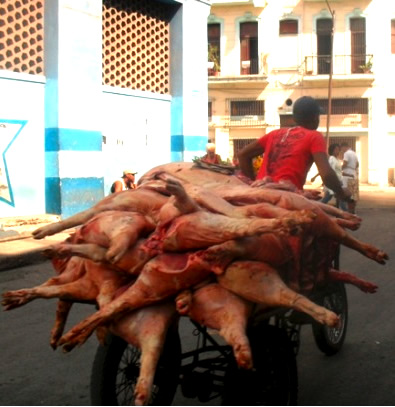
It’s five in the morning and they are beginning to pile a few pieces of port on the stand. They’ve made the long and rugged journey from a private farm to get to this market in the city. They will only have meat to sell until mid-morning, because the demand exceeds what the sellers can offer. A good part of the domestic economy will be determined by this product. Its rising price affects the cost of a steak sandwich that a bricklayer might eat at his work site, or that of the chicharrones that a mother puts on the table for her children’s lunch. So many things revolve around those extra pounds of fat, bone and fibers, that any shortage or lack affects the everyday fabric of survival.
However, behind the chops and sausages is a product as important as it is difficult to get: the feed for the pigs. The weakest link in the agricultural chain is “food for the pigs,” a real headache for many Cuban peasants. The State remains the leading manufacturer of this product, in part because the private sector doesn’t have the raw materials or the technical capacity to obtain it.
After decades pf accumulated complaints and of underweight animals, Cuba still has not managed to achieve stable high quality nutrition for farm animals. Traveling through the fertile plains that make up the western and central areas of the county, one is surprised by the great amount of uncultivated land. It could be planted with grains and vegetables that would help to increase the mass of the country’s swine. For now, these extensive land abound in weeds.
The State entities sell pigs after they are weaned, and also part of the feed they consume, to the producers. The farmers incur a debt that they will repay with the animals themselves after they are slaughtered, leaving some profit for themselves. Explained in this way, it seems fair. However, the whole process is full of irregularities, diversion of resources and corruption. The functionaries of the agricultural sphere sometimes falsify the weights, artificially increasing what they deliver to the farmers and reducing what they receive from them. In addition, the distribution of the feed is not completed, or simply never occurs.
To be able to fatten the animals, the private producer then uses products that are contraindicated for the health of the consumers. Excessive doses of antibiotics, food scraps collected from garbage dumps in the large cities, and even the offal and remains of the pigs themselves. In some cases so-called “fishmeal” will be the only thing the pigs ingest in their brief lives, giving the meat a now characteristic flavor in many Cuban dishes.
When a pound of pork is slaughtered, in most cases it’s because feed is scarce. A close relationship that alters the domestic economy and quality of life for so many Cubans. It starts with a sack of feed that doesn’t arrive on time to the farm trough, but ends with a woman who leaves the market with an empty sack.
8 December 2013
